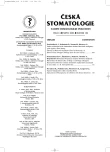Adjustment of Physiognomy in Children with Down Syndrome
Authors:
K. Nováková 1; B. Polášková 2; E. Fritschová 1; K. Langová 3
Authors‘ workplace:
Klinika zubního lékařství LF UP a FN, Olomouc
přednosta prof. MUDr. M. Eber, CSc.
1; Ordinace klinické logopedie Olomouc
2; Ústav lékařské biofyziky LF UP, Olomouc
přednosta prof. Ing. J. Hálek, CSc.
3
Published in:
Česká stomatologie / Praktické zubní lékařství, ročník 106, 2006, 4, s. 115-122
Overview
The aim of the work was to evaluate the possibility to adjust physiognomy of children with Down syndrome and to create our own modification of the Castillo-Morales method. The cohort included 25 children at the age of 0.5 to 8.22 years and the mean age of 2.79 year. The position of tongue was evaluated in 5 variations, the time of opened mounth for the period of 2 minutes and the lip occlusion in 4 variants in the entry examination and at the end of treatment of dispensary. The therapy was started by a logopedist with individually aimed logopedic exercise, originating in the principles of developmental therapy of neuromotoric skills and digital stimulation of selected points of the face. Pediatric stomatologist applied the exercise by confection vestibular screen, indicated an individual palatal plate with adequate stimulation elements according to age with two oval symmetric resin pelotae: protrusion of the tongue (in entry examination protruding from the mouth in 40% of children) was adjusted in all subjects at the end of the treatment. The long-term opened mouth was observed in 56% of the cohort during the entry examination, but in one child only at the end of dispensary. The permanently closed mouth was detected in the entry examination in 4% of the cohort and in 64% of them at the end of dispensary. A free lip occlusion (in 76% during the entry examination) was markedly adjusted (present in 12% of the cohort at the end of dispensary) and the ability to purse one’s lips was increased from 4% of the cohort in entry examination to 56% of the cohort at the end of dispensary.
It has been proved that the adjustment of physiognomy in children is possible not only at the suckling age, but it is more demanding: the extended complex therapy originating in the Castillo-Morales method, acupressure exercise, myofunctional therapy, special logopedic knowledge, vestibular screen and general muscular (aerobic) excecise.
Key words:
Down syndrome – Castillo-Morales method – therapy – palatal plate – vestibular screen – lip occlusion adjustment
Labels
Maxillofacial surgery Orthodontics Dental medicineArticle was published in
Czech Dental Journal

2006 Issue 4
Most read in this issue
- Alternative Preparation Techniques in the Treatment of Dental Caries
- Adjustment of Physiognomy in Children with Down Syndrome
- Therapy of Recurrent Aphthous Ulcer by Removing of Electro-active Amalgam Fillings from the Oral Cavity
- Analysis of Dental Caries in 5-year Children
